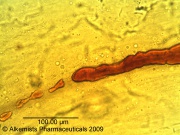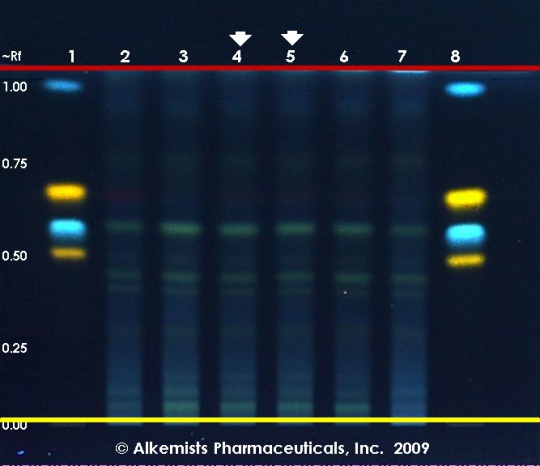Carthamus tinctorius (flower)
(Nomenclature updated) |
(Various title corrections) |
||
| Line 1: | Line 1: | ||
| + | {{DISPLAYTITLE:''Carthamus tinctorius'' (flower) }} | ||
| + | |||
=Nomenclature= | =Nomenclature= | ||
| Line 11: | Line 13: | ||
|notes= }} | |notes= }} | ||
| − | =Macroscopic | + | =Macroscopic Characteristics= |
{{Macroscopy | source=United States Dispensatory (1918) | {{Macroscopy | source=United States Dispensatory (1918) | ||
| description=''Carthamus tinctorius'' L. ''Safflower''.— | | description=''Carthamus tinctorius'' L. ''Safflower''.— | ||
| Line 19: | Line 21: | ||
}} | }} | ||
| − | =Microscopic | + | =Microscopic Characteristics= |
{{Microscopy | source=Elan M. Sudberg, Alkemist Laboratories | {{Microscopy | source=Elan M. Sudberg, Alkemist Laboratories | ||
| companyimage= AP-LOGO-Laboratories Crop - Copy.jpg | | companyimage= AP-LOGO-Laboratories Crop - Copy.jpg | ||
| Line 34: | Line 36: | ||
| − | = | + | =High Performance Thin Layer Chromatographic Identification= |
{{HPTLC | source=Elan M. Sudberg, Alkemist Laboratories | {{HPTLC | source=Elan M. Sudberg, Alkemist Laboratories | ||
| description=Safflower (flower) (''Carthamus tinctorius'') | | description=Safflower (flower) (''Carthamus tinctorius'') | ||
| Line 61: | Line 63: | ||
| − | = | + | =Supplementary Information= |
[[Category:NoIntro]] | [[Category:NoIntro]] | ||
Revision as of 21:13, 15 March 2014
Contents |
Nomenclature
Carthamus tinctorius L. Asteraceae
Standardized common name (English): safflower
Ayurvedic name(s): kusumbha
Pinyin name(s): hong hua (flower)
Macroscopic Characteristics
|
Microscopic Characteristics
|
High Performance Thin Layer Chromatographic Identification
|
Safflower (flower) (Carthamus tinctorius) Lane Assignments Lanes, from left to right (Track, Volume, Sample):
Reference materials used here have been authenticated by macroscopic, microscopic &/or TLC studies according to the reference source cited below held at Alkemists Laboratories, Costa Mesa, CA. Stationary Phase Silica gel 60, F254, 10 x 10 cm HPTLC plates Mobile Phase ethyl acetate: AcCOOH: HCOOH: H2O [10/1.1/1.1/2.4] Sample Preparation Method 0.3 g + 3 ml CH3OH sonicated + heated @ 50° C ~ 1 hr Detection Method Natural Product Reagent + PEG -> UV 365 nm Reference see Adapted from Plant Drug Analysis, Wagner, H., 1996
|
Supplementary Information
Cite error: <ref> tags exist, but no <references/> tag was found


